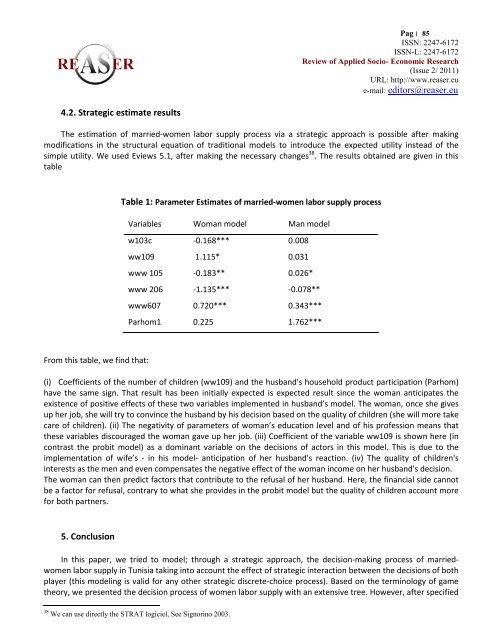Pag׀ 84 ISSN: 2247-6172ISSN-L: 2247-6172<strong>Review</strong> <strong>of</strong> <strong>Applied</strong> <strong>Socio</strong>- <strong>Economic</strong> Research(Issue 2/ <strong>2011</strong>)URL: http://www.reaser.eue-mail: editors@reaser.euknowing the choice <strong>of</strong> his wife, the expected and desired husband’s reaction is acceptance the decision <strong>of</strong> his wife.So husband's decision is positive (denoted y = 1 ) if he accepts that his wife quit his job and this is explained bymthe positive utility ( y* ≥ 0 ) touched by the husband after non-participation <strong>of</strong> his wife in the labor market. Thenmthe man reacts as his model written as follows:andym,i⎪⎧1= ⎨⎪⎩ 0ifify*m,iy*m,i≥ 0< 0⎪⎧ifand ⎨ ⎪⎩ ifyy*m,i*m,i*ym, i= Ziβ + ε 372,i≥ 0 ⇒ man accepts the decision <strong>of</strong> his wife< 0 ⇒man refuses his wife's decision4. Estimation and Results4.1. DataThis study uses data from the Survey PAP-FAM, realized in 2001 by the National Family and Population <strong>of</strong>fice(ONFP) <strong>of</strong> Tunisia. The survey covers 6691 households representing 4346 couples (women aged 15 to 54 years). Itconsists <strong>of</strong> several questionnaires including the household questionnaire that describes the household concerned,providing information on its composition, socioeconomic characteristics <strong>of</strong> its members, job, spouse's age,educational level <strong>of</strong> each one <strong>of</strong> them, marital status, residence and information on parents and children. Of otherquestionnaires that describe the health, the type <strong>of</strong> housing and other phenomena. Furthermore, the scenariothat should be studied in this paper is as follows: here, there are women who want to quit job after marriage for aspecific reason. We assume that this decision is the result from the fact that they want to care for their children's.Such a decision <strong>of</strong> married women may be accepted or refused by their spouses. We have a sample <strong>of</strong> 1396 pairs<strong>of</strong> observations (man-woman) that all women have participated before marriage in the labor market and thisexplanatory variables are: age <strong>of</strong> woman denoted w103c (from 16 to 54 years), number <strong>of</strong> children denotedww109 (between 0 and 12 children), number <strong>of</strong> woman education years denoted ww105 (between 0 and 20years), pr<strong>of</strong>ession <strong>of</strong> woman denoted www206 (decomposed into 6 modalities: 1-worker, 2 –specialized worker,3- trader, 4- middle qualified skills, 5- high qualified skills, 6- liberal pr<strong>of</strong>essional), participation <strong>of</strong> woman inexpenditures Household denoted www210 (decomposed in 5 modalities: 1 – almost nothing, 2 – less than half, 3 –almost half, 4 – more than half, 5 - all expenses), woman fathers job denoted ww310 (same modalities <strong>of</strong> thevariable www206), woman mother’s job denoted ww311 (same modalities <strong>of</strong> the variable www206), husband’sage noted ww609 (varied between 22 and 98 years), number <strong>of</strong> years <strong>of</strong> schooling <strong>of</strong> husband denoted ww602(range in 0 to 20years), pr<strong>of</strong>ession <strong>of</strong> man denoted www607 (same modalities <strong>of</strong> the variable www206), husband'sparticipation in household product denoted “parhom” (in our case the product <strong>of</strong> the household is the quality <strong>of</strong>children, the variable “parhom” is determined by the degree <strong>of</strong> participation <strong>of</strong> husband in each <strong>of</strong> these tasks:education <strong>of</strong> children (in term <strong>of</strong> time), punishment <strong>of</strong> children and child health. Therefore, the variable parhomobtained is decomposed into three modalities: 1 –almost nothing, 2 – sometimes 3 - always). For couples withoutchildren, we assume that parhom = 3) and the milieu variable denoted by wmili1 = 1 if the area is urban and"0"otherwise.Before estimate the strategic model <strong>of</strong> our decision process, we use the simple probit model to our data. Theprincipal result derived from the probit estimates is that the woman expects that the financial side is the mainfactor that explains the refusal <strong>of</strong> the husband's decision to quit job. From these estimates, we retain thepertinent variables in explaining the labor supply <strong>of</strong> married women to use in the strategic estimate.37ε2 is a random disturbance, assumed to be normally distributed with mean zero and variance one.
Pag׀ 85 ISSN: 2247-6172ISSN-L: 2247-6172<strong>Review</strong> <strong>of</strong> <strong>Applied</strong> <strong>Socio</strong>- <strong>Economic</strong> Research(Issue 2/ <strong>2011</strong>)URL: http://www.reaser.eue-mail: editors@reaser.eu4.2. Strategic estimate resultsThe estimation <strong>of</strong> married-women labor supply process via a strategic approach is possible after makingmodifications in the structural equation <strong>of</strong> traditional models to introduce the expected utility instead <strong>of</strong> thesimple utility. We used Eviews 5.1, after making the necessary changes 38 . The results obtained are given in thistableTable 1: Parameter Estimates <strong>of</strong> married-women labor supply processVariables Woman model Man modelw103c -0.168*** 0.008ww109 1.115* 0.031www 105 -0.183** 0.026*www 206 -1.135*** -0.078**www607 0.720*** 0.343***Parhom1 0.225 1.762***From this table, we find that:(i) Coefficients <strong>of</strong> the number <strong>of</strong> children (ww109) and the husband's household product participation (Parhom)have the same sign. That result has been initially expected is expected result since the woman anticipates theexistence <strong>of</strong> positive effects <strong>of</strong> these two variables implemented in husband’s model. The woman, once she givesup her job, she will try to convince the husband by his decision based on the quality <strong>of</strong> children (she will more takecare <strong>of</strong> children). (ii) The negativity <strong>of</strong> parameters <strong>of</strong> woman’s education level and <strong>of</strong> his pr<strong>of</strong>ession means thatthese variables discouraged the woman gave up her job. (iii) Coefficient <strong>of</strong> the variable ww109 is shown here (incontrast the probit model) as a dominant variable on the decisions <strong>of</strong> actors in this model. This is due to theimplementation <strong>of</strong> wife’s - in his model- anticipation <strong>of</strong> her husband's reaction. (iv) The quality <strong>of</strong> children'sinterests as the men and even compensates the negative effect <strong>of</strong> the woman income on her husband's decision.The woman can then predict factors that contribute to the refusal <strong>of</strong> her husband. Here, the financial side cannotbe a factor for refusal, contrary to what she provides in the probit model but the quality <strong>of</strong> children account morefor both partners.5. ConclusionIn this paper, we tried to model; through a strategic approach, the decision-making process <strong>of</strong> marriedwomenlabor supply in Tunisia taking into account the effect <strong>of</strong> strategic interaction between the decisions <strong>of</strong> bothplayer (this modeling is valid for any other strategic discrete-choice process). Based on the terminology <strong>of</strong> gametheory, we presented the decision process <strong>of</strong> women labor supply with an extensive tree. However, after specified38 We can use directly the STRAT logiciel, See Signorino 2003.








